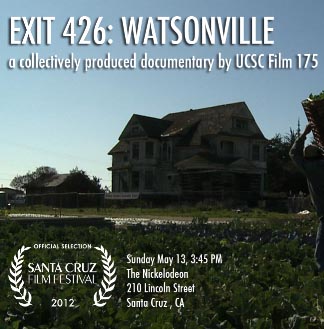Exit 426: Watsonville—a completely collaborative film made by 20 students in a UC Santa Cruz film class--will have its premiere on Sunday, May 13, at the Nickelodeon Theater in Santa Cruz.
Guided by UCSC film and digital media professor Irene Lusztig in her winter quarter Intermediate Documentary Production course, the students spent three months exploring the many different faces of the city of Watsonville.
Every aspect of the project was produced collectively, from research to shooting to editing. Filmed and edited in a patient, meditative observational style, the result is a chronicle of the sights and sounds of Watsonville.
Professor Lusztig noted that in most of UCSC’s film production classes, students make several individual short video projects per quarter.
She said that while this model has many benefits—such as letting students graduate with a nice portfolio--it means that students rarely get to spend time working together on a large project.
“Learning modes of working collaboratively is important,” said Lusztig. “Students who go through a process like this not only learn a lot about filmmaking, but also learn a lot about how to negotiate their ideas with other students…how to be accountable for their work in a group.”
Lusztig added that in the real world, most documentary filmmakers do not generally create their projects alone.
“More commonly, documentaries are made by a complex network of collaborators that might include producers, directors, research assistants, cinematographers, sound designers, and many others. These people work together, talk things through, and combine their strengths to make projects.”
The film students basically worked in research and production groups of two. Each group went on at least four shoots, and they had to come up with their own four topics in Watsonville.
The students spent about three weeks researching and trying to develop contacts in Watsonville, and another four weeks shooting and cutting short scenes out of their video material.
“By week seven, we had collectively generated about 40 hours of footage, which was great,” said Lusztig. “One of the benefits of a group project is that you can produce a lot of footage really quickly, which really teaches students about how to work with a high shooting ratio, starting with 40 hours and cutting it down.”
Once the class had all of its scenes and put them together, they found their first cut totaled nearly three hours. The students then began the process of many group discussions about structure to make crucial decisions--such as which scenes were working, what to cut, how to order things, and how to start and end the film.
All of those editing decisions were made by consensus. Once the class had a shorter, 80-minute finished edit they were happy with, the students again worked in smaller groups to do tasks like sound mixing and color correction to complete the film.
“I think most students had really positive responses to how the process worked, and I think they did amazing work,” Lusztig observed. “These students were able to make a feature length film in 10 weeks, which is pretty incredible, and definitely not something one student could do alone.”
“I'm now teaching a senior projects documentary class with some of the same students, and I am definitely seeing more socially-engaged, research-driven documentary projects than I usually do,” Lusztig added. “So I think the process has been influential.”
____________________________________________________________________________________________________________________
Exit 426: Watsonville will have its premiere on Sunday, May 13, at the Nickelodeon Theater in Santa Cruz as part of the 2012 Santa Cruz Film Festival.



